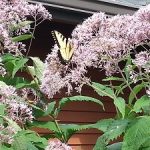by Winding Pathways | Aug 30, 2016 | Mammals, Nature, Pests
A long-ago children’s story began something like this, “There is a mouse in my house. It is a very nice mouse. It has a long, long tail and shiny eyes. It pops out of its hole and runs. My mother likes the mouse, but she says, ‘A mouse does not belong in a house.’”
Well, guess what, a sure sign that fall is approaching is “a mouse in the house.” These tiny mammals realize that shorter days and cooler temperatures beckon winter. Finding a safe warm place to live with an abundance of food helps them survive the tough season.
At Winding Pathways we expect mice to appear with the first cool weather in late August or September. Once in a while we have seen one scurrying across the floor, but more often we have found their tiny black droppings on counters. Sometimes we have heard them scurrying about an upstairs closet.
Two types of mice inhabit houses. Both gobble birdseed and will eat nearly anything people do. They capable of doing damage and possibly spreading disease.
The common house mouse is a gray mammal native to the Old World that is now found everywhere people live. They like houses, barns, garages, and sheds but are rarely found far from buildings and live indoors all year round.
Several species of native mice live outdoors most of the year but move inside each fall. These are normally called deer or field mice and are beautiful tiny mammals with shiny eyes and white feet.
They store food, while house mice don’t. Find a pile of sunflower seeds in a shoe and the culprit is a native mouse.
We love wildlife but don’t tolerate mice in the house. So, each fall we plan an eviction campaign.
Here’s how we reduce mouse problems at Winding Pathways:
- Tighten up cracks and holes. Every fall we arm ourselves with a caulking gun and can of expanding foam and inspect the house from the outside and inside. We fill in any likely entryway for mice, which can squeeze through tiny spaces. Caulking also helps keep insects and cold air out of the house.
- Set up a trap line. Old fashioned mouse traps efficiently catch and instantly kill mice if set properly. Here are some effective trapping tips:
- Buy many traps and set them all at once. Try to catch all or most mice in one night, rather than just setting a few traps.
- Bait traps with peanut butter and set them with the trigger side against the wall where mouse evidence is noticed. Mice tend to run along walls, rather than across the interior of a room, so trapping success is usually best near a wall.
- Set traps in tandem. Instead of just setting one trap here and there along a wall double or triple them up side by side, again with the trigger side facing the wall.
- We don’t use poison. It seems cruel and inhumane and poisoned mice tend to die in inaccessible places and stink to high heavens.
- Encourage predators. We don’t have a cat but encourage raptors to visit our yard. They work year round reducing rodent numbers.
- Mice are encouraged by food. We keep all food in sealed metal containers or in the refrigerator and wipe up any spilled food. Wild bird and pet foods are loved by mice. Keep them in a metal can with a tight lid and dump out the dog or cat’s food dish in the evening so there’s nothing for nocturnal mice to eat.
Mice are fascinating animals that play an important role in nature, but they belong outside. It’s probably not possible to entirely eliminate them from a house but simple techniques will encourage them to stay outdoors.
by Winding Pathways | Aug 26, 2016 | (Sub)Urban Homesteading, Garden/Yard, Nature, Trees/Shrubs

A Guest Column by Jackie and Peter Hull
When we first moved to Virginia fifteen years ago, we had no idea that the entire state was in a drought which had been ongoing for a couple of years. In order to help water the garden we wanted to grow, we decided to construct rain barrels. We had seen the master gardeners of Bedford, VA, demonstrate how to put them together.
To begin we bought four 55-gallon barrels from Southern Flavorings for $10 apiece. The faucets and pool filters added another $15 bringing the total to $25 a barrel as opposed to $75 to $100 a piece fully equipped from a company. When we modified our barrels a few years later no longer using pool filters, we had to add the cost of screening and bungee cords which made a total of $30 a barrel.
In outfitting the barrels Peter cut circular holes in the top of each barrel and fitted them with pool filters to catch debris and give an access to help clean out the barrels in the fall. About five inches from the bottom of the barrels he cut holes just large enough to insert the faucets and rings. To help seal this entrance he used caulking compound. He modified the down spout of the rain gutter to arc over the pool filter to catch the rain. The remaining barrels sat adjacent to the first barrel and each was attached to the other with a short piece of PVC pipe that was inserted from one barrel to the next so the water would flow filling each barrel. The last barrel had an overflow spout at the top pointing to the ground so once it was filled the rain water could dribble to the ground.
As we added more barrels, Peter changed from cutting holes in the top of the barrels to cutting the entire top off and covering with plastic screen and using a bungee cord. Fortunately, the top of each barrel has a lip so the bungee cord fits snugly around the barrel holding the screen securely in place. His thinking was this would make cleaning the barrels much easier. It is. To keep mosquito larvae to a minimum, we put a mosquito donut into each barrel. The screening also protects the birds which was initially my concern when he decided to cut the tops entirely off.
All the barrels sit on benches that we constructed so that the water is gravity fed to the garden through a number of hoses. Over the past several years we’ve added more barrels for a total of eleven rain barrels containing 55 gallons each for a total of 550 gallons of water collected from the metal roofed house and garage. This year we’ve emptied them twice over the growing season as we’ve had alternating rain and warm sunshine.
Winding Pathways Notes: Some people may prefer to buy rain barrels ready to install. Most large home improvement stores sell barrels as do many nature centers. Also, be aware that in some arid areas harvesting rain water is in dispute or illegal unless a person owns the water rights. These laws are changing as times and uses change.
by Winding Pathways | Aug 21, 2016 | Labyrinths, Wonderment

This lovely labyrinth is tucked among evergreens and surrounded by cool and calming plants. A treasure.
August was a time of travel East. On the way to and from we took in labyrinths in towns just off I-80. South Bend and Valaparaiso, Indiana, both have lovely labyrinths. The South Bend labyrinths are located on Ironwood Road, a major north-south route close to Notre Dame University. Both are at churches and one is especially well-named: Saint Thérèse Little Flower Catholic Church. How cool is that!
Of the Valparaiso labyrinths, two are on Valparaiso University campus. The other is downtown at the First United Methodist Church. Excellent all! Read about them on 1080 Labyrinths.
by Winding Pathways | Aug 20, 2016 | Bugs, Flowers/Grasses, Nature

Joe-Pye Weed can grow to great heights and is a favorite of butterflies and other pollinators.
Carol Lampe shared these pictures and write up of her wondrous yard and the pollinator action on Joe-Pye Weed (Eupatorium purpureum). This is a particularly valuable fast food stop for migrating butterflies as it lasts into autumn. We have found it a bit difficult to start and then it takes off! Give it plenty of space and enjoy the butterflies.
“Here is a butterfly twofer from my flower bed. In the forefront you can see the female Eastern Tiger Swallowtail (Papilio glaucus) sitting on a Joe-Pye Weed. There were several Swallowtails out there that day.
“Joe-Pye Weed is an herb and the butterflies really seem to like it. Native Americans, and later, white settlers, made much use of Joe-Pye Weed. Teas of the roots or tops were used as a diuretic, as well as for rheumatism, gout, fevers, diarrhea, respiratory disorders, and even impotence. Modern science has not confirmed their efficacy.

Sipping nectar on Joe-Pye Weed.
“Tucked toward the back is a Red Admiral (Vanessa atalanta). The males are territorial and many times can be found in the same location day to day.”
Thanks, Carol, for sharing your wondrous yard with Winding Pathways.
by Winding Pathways | Aug 8, 2016 | Bugs, Flowers/Grasses, Nature, Reflections/Profiles, Wonderment
Here is a story fro Gordon and Nancy Bena about their interest in Monarchs, their chrysalis find and how they began to tend their property differently to encourage insects.

Adult butterflies need nectar to sip and plants to rest on.
“We went to the presentation given at the library that told us the fate of the Monarch. With that we were very careful not to mow down any Milkweed plant that we saw in the yard. We also planted Butterfly Weed and I did not mow any of the clover down this year.
“This particular plant where we found the chrysalis was kind of blown over from one of the wind storms and we put a tomato cage around it to hold it up so the caterpillars would have something to munch on. When I went down to get the mail the other day, I stopped to check that the plant was still standing. This is when I found the chrysalis. I went around to the other plants but I’m afraid that this is the only success story I found so far.”
Thanks, Gordon and Nancy!





